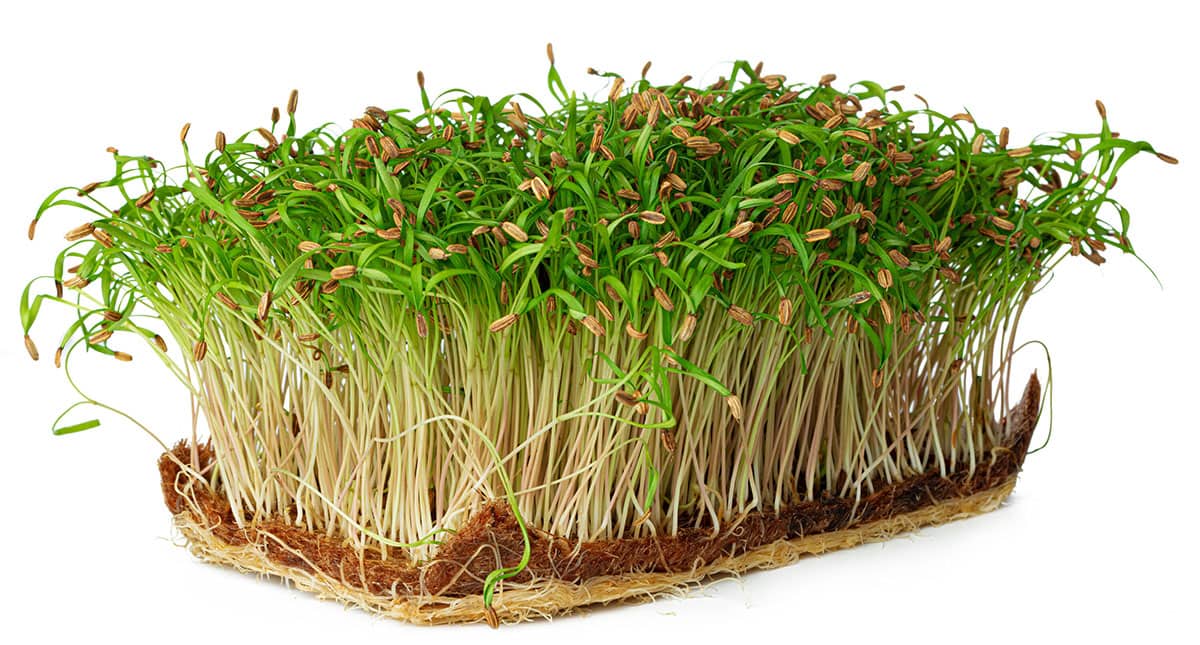10 Microgreens to Grow All Year Round
The microgreens business is expanding and beginner gardeners are loving it. They grow really fast and will be ready for you to reap all year round. Planting and harvesting your own organic microgreens will provide you with unlimited food. Here are 10 microgreens to grow all year round.
There’s nothing better than enjoying the natural flavors and collective bursts of nutrients from fresh fruits and vegetables. Microgreens are also called “vegetable confetti” because of their small size. They have bright and beautiful colors with intense aromatic flavors when used to make delicious meals. These young vegetables remain between 1 to 3 inches tall but are filled with nutritional value.
If you’d like to add a bit more fusion to your diet, restaurant business or even to try something new, microgreens are the way to go. It’s very fun to try and an excellent activity to keep your family members active, especially children.
They’ll be able to nurture their very own plant and harvest the reward in a very short time. Strolling into a store to grab a few microgreens is easy. However, the downside is they can be quite pricey and will only last a short while.
Considering how tasty microgreens really are, you’ll be left wanting more. So why not invest in a few packs of seeds? You’ll be able to save money on vegetables while reaping all the nutrients you need in a bulky supply. Hey, you might even have to share your rewards or sell some due to limited storage.
Also see, Broccoli Microgreens, Best Vegetables For The Kitchen Garden, and Healthiest Leafy Greens To Consume.

1. Radish
Micro radishes are a top pick for beginners. They are easy to handle, germinate fast, and will be ready for harvest in approximately 7 to 10 days of planting the seeds. The two types of radish microgreen that you can find on the market are the Confetti Radish Mix and the Red Stem Radish.
Both are lovely and will spring lots of flavor and crunch in your meals. Another great quality is that it provides a lot more nutrients than a fully grown radish. It will improve your cardiovascular system, help prevent cancer, and the low calories also contribute to weight loss. It’s a whole lot of benefits in a tiny vegetable and totally worth the try.

2. Broccoli
Microgreen broccoli is without a doubt tasty and much less bitter than its more developed counterpart. After planting the seeds, they will be ready to reap within 7 to 15 days. It’s like a healthy version of fast food in comparison to the more mature broccoli.
You’ll have several plates filled with delicious salads and a lovely texture that can be stacked in a variety of meals. If this sounds great but you don’t have an outdoor garden don’t let that stop you. Broccoli microgreens can be grown indoors too.
Use a shallow tray with proper drainage holes and get some loamy soil. Having a great source of light like a balcony or windowsill is important. Without direct sunlight, you’ll need to invest in a grow light.

3. Beetroot
Beetroot takes a little more time to harvest than other microgreens. While waiting you can think of all the great recipes to try and put it all into action within 2 to 3 weeks. In the end, however, the colorful outcome and healthy vegetables are definitely worth it.
Beets are a delicious root vegetable with a somewhat earthy flavor. There are several seeds available on the market and they do not need much water to sprout. So, there’s no need to worry about receiving a huge water bill due to its watering needs.
The roots are very delicate so a pot with great drainage is needed. If you like beets then microgreens will have you reaping all year.

4. Spinach
For a more nutritious version of the actual plant, spinach microgreens can be used in almost any meal. Regular consumption improves your eyesight and manages high blood pressure. The leafy greens have a mild texture stacked with Vitamin A, Vitamin C, Iron, Folic Acid, and calcium.
Think of all the benefits microgreen spinach will contribute to your health. I’m not talking about store-bought spinach with pesticide residues on them. I’m referring to planting and harvesting the nutrients you need from your own organic vegetable garden.
Spinach is known to have dietary magnesium that will give you that extra boost of energy all while maintaining both the nerve and muscle functions.

5. Collards
Collards remain one of the easiest microgreen veggies to grow indoors throughout the year. They’re easy to grow and will be ready to harvest within an estimated 10 to 12 days. Its mild and tender dark green leaves are intensely flavorful and highly nutritious for garnishes, salads, and sandwiches. Vitamin C, vitamin B6, vitamin A, magnesium, calcium, and iron are rich in collard microgreens
. Thanks to the high fiber content these microgreens will help to decrease high cholesterol levels and blood pressure. All the benefits will improve your heart health, and limit the risk of cancer. It’s a great detoxifier for your liver and helps with indigestion. I could go on about the reasons why you should sow microgreen collard seed in your garden. It guarantees a win for different areas of your health.

6. Basil
Unlike the more mature basil, the microgreens are less likely to rot and attract powdery mildew. It’s stacked with health benefits containing Vitamin A, Vitamin B, Vitamin C, K, and B6. You’ll also be able to incorporate some calcium, zinc, and magnesium into your diet among other benefits.
You may think small vegetables mean fewer nutrients and flavor but that’s definitely not the case. Microgreen basil does tend to take a lot slower to develop, as germination takes up to 2 days and an estimated 15 to 20 days to harvest. However, it’s all worth it in the end.

7. Kale
Growing microgreen kale is easy and hard to mess up even for beginners. Most of the materials you need to start are in your house besides the seeds. With a container, soil, a spray bottle, LED lights, or direct sunshine, there will be enough kale for you and your family in 10 days or less.
This is one of the best organic nutrient-dense superfoods! Even though they hold up to 4 times the nutrients of the more leafy and mature kale, they remain low on calories. It’s packed with antioxidants, calcium, potassium, and vitamins A, B6, C, and K1. It grows well in both soil and hydroponic mediums.

8. Fennel
Looking for that extra zingy and pepper flavor in your meals? Then fennel microgreens should be the vegetable of your choice. It’s easy to nurture and adds a deliciously mild and sweet taste to dips, soups, salads, or simple sandwiches.
The health benefits include potassium, vitamins, fiber, and antioxidants. It’s great for improving your eyesight and reduces bloating indigestion and constipation. It takes 7 to 14 days to be perfect for harvest, and may even take less if the seeds are soaked overnight.
This is because fennel seeds are slow to germinate so hydrating them before sowing will speed up the process significantly.

9. Mustard
If you’re always purchasing a bottle of mustard at the supermarket then you’ll love this hot and spicy sweet microgreen. They’ll take between 5 to 14 days to harvest and are greens that you can grow at all times during the year.
They also have a lot of antioxidant qualities, which make them appealing to cooks and food enthusiasts. Besides the distinct taste, mustard microgreens are filled with fiber, calcium, folate, and iron.
It contains vitamin C which will help to build your immune system and fight diabetes as well as other lifestyle conditions. For healthy hair growth stimulation, this vegetable is a plus.
10. Cauliflower
For a microgreen that is as nutritious as they’re easy to grow, cauliflower is an excellent choice. They have a sweet, somewhat peppery, broccoli-like flavor that makes them a great addition to salads.
Their high germination and consistent growth rate make them an all-time favorite. It takes up to 8 days and often times 12 days to harvest in bulk. Filled with vitamins, minerals, and antioxidants, this microgreen lowers the risk of heart disease.
Other Related Articles
- Vegetables You Can Eat Every Part Of
- Vegetables For Salads
- Vegetables To Grow In The Summer
- Easy Fruits And Vegetables To Grow
- 12 Ways To Increase Your Yield From Your Vegetable Garden
Conclusion
This is it, folks!
These are 10 of the best microgreens to grow all year round. All of them are quite easy to grow and will add a burst of different flavors to your daily diet. The health benefits are amazing and planting them will give you a huge supply to last for a while.
They can all be grown indoors too, so not having an outdoor garden should not be the only reason that’s stopping you from giving it a shot.
If you enjoyed this post about the 10 Microgreens to Grow All Year Round and would love to see more, join me on Youtube, Instagram, Facebook & Twitter!
Get discounted copies of my cookbook here.
Fortunately, because of the ads on our website, readers and subscribers of Healthier Steps are sponsoring many underprivileged families. Thank you!






